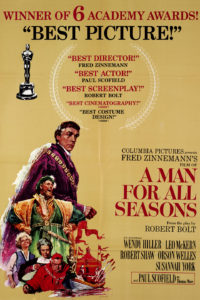In today’s Wall Street Journal “Sightings” column I talk about the decline of the play-based film. Here’s an excerpt.
* * *
Fifty years ago, “A Man for All Seasons” and “Who’s Afraid of Virginia Woolf?” hit big at the box office and tore up the Oscars. Yet both films were screen versions of dead-serious Broadway plays that came out in the same year as the undemanding likes of “Fantastic Voyage” and “Our Man Flint.” How could so challenging a pair of movies possibly have gone over with the popcorn set?
 Viewed from the vantage point of 2016, the year of “Batman v Superman: Dawn of Justice” and “My Big Fat Greek Wedding 2,” the mere existence of these two films may seem like a cultural miracle. Yet it used to be standard operating procedure for Hollywood. In 1966 it was still perfectly normal for hit plays to be turned into big-budget movies. Most of them, to be sure, were fluffy comedies like “Arsenic and Old Lace” and “The Odd Couple,” but Hollywood also made a point of filming such critically acclaimed dramas as “The Little Foxes,” “Picnic” and “A Streetcar Named Desire,” all three of which did quite well at the box office.
Viewed from the vantage point of 2016, the year of “Batman v Superman: Dawn of Justice” and “My Big Fat Greek Wedding 2,” the mere existence of these two films may seem like a cultural miracle. Yet it used to be standard operating procedure for Hollywood. In 1966 it was still perfectly normal for hit plays to be turned into big-budget movies. Most of them, to be sure, were fluffy comedies like “Arsenic and Old Lace” and “The Odd Couple,” but Hollywood also made a point of filming such critically acclaimed dramas as “The Little Foxes,” “Picnic” and “A Streetcar Named Desire,” all three of which did quite well at the box office.
Why were such movies made? Because the plays on which they were based had high name recognition, not just in New York but throughout America. You didn’t have to be a bred-in-the-bone Manhattanite to know who Lillian Hellman, William Inge and Tennessee Williams were: You could read about them in Time, Life and Newsweek, which routinely covered Broadway openings, just as stage actors and playwrights appeared no less routinely on popular TV shows like “Tonight” and “What’s My Line?” Because of this coverage, theater was a part of the national cultural conversation. The citizens of Dubuque knew who Stanley Kowalski was long before they went to the neighborhood movie house in 1951 to see “A Streetcar Named Desire.” They’d already seen Eliot Elisofon’s beefcake-worthy photograph of Marlon Brando kneeling before Kim Hunter in Life’s 1947 feature story about the Broadway production. This meant that a hit play was not merely grist for the Hollywood mill but a hot property in its own right….
* * *
Read the whole thing here.
A scene from the film version of Who’s Afraid of Virginia Woolf:
